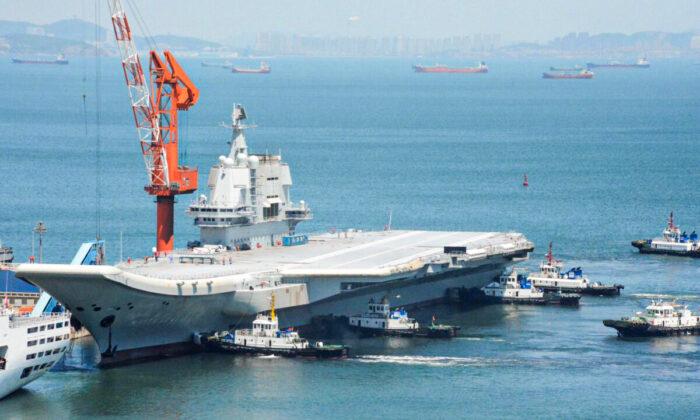China is set to launch a new aircraft carrier and destroyer in the coming months, continuing the rapid expansion of its naval forces. Experts believe that foreign investments in China could be fueling the construction of the ships.
China’s third aircraft carrier, the Type 003, will likely be ready for launch in three to six months, according to
analysis of satellite images by the Washington-based think tank Center for Strategic and International Studies (CSIS).
The Type 003 has been in development since 2015 and will be China’s first modern aircraft carrier. Unlike its other carriers, the Liaoning and Shandong, the Type 003 will likely be equipped with
electromagnetic launch catapults that will allow it to field aircraft with heavier payloads and more fuel.
The United States and France are currently the only two nations in the world that have aircraft carriers equipped with catapult systems.
“The inclusion of catapults on the Type 003 is a major leap forward for the
People’s Liberation Army Navy (PLAN),” the CSIS report said.
Though the ship may launch in as soon as three months, it will not reach full operational capacity within China’s navy for some time. The Pentagon’s latest
report on China’s military power estimated that the carrier would reach full operation by 2024.
The ship’s construction is nearing completion at the
Jiangnan Shipyard, just northeast of Shanghai. It is as
large a construction as is possible for the shipyard, and the authors of the CSIS report believe that foreign orders could be funding the gigantic work.
“The foreign capital flowing into Jiangnan and the dozens of other shipyards that dot China’s coast may both directly and indirectly help buoy the ongoing modernization of the PLAN,” the report said.
This is because roughly 55 percent of Jiangnan’s construction from 2018 to 2020 was for foreign-owned vessels. The report notes that a French-owned merchant vessel was being built in the same drydock as the Type-003 just days before the carrier was moved there.
This is problematic in terms of funding, as the owner of the shipyard proudly boasts of the work it does in building China’s defense vessels, experts say. In a system, where there is virtually no distinction between military and civilian spending, this can pose a risk.
“Between 2018 and 2020, Jiangnan received orders to build at least 49 commercial vessels, more than half of which were for companies based outside of mainland China or Hong Kong,” said another
report by the same authors.
“By purchasing vessels from Chinese shipyards, foreign companies are immersing themselves in an opaque ecosystem where demarcations between commercial and military shipbuilding activities are either unclear or nonexistent.”
Additionally, the Chinese regime is
expected to launch its fourth Type 055 destroyer next month, according to the South China Morning Post. The Type 055 is a large, multi-role vessel that can serve as the lead ship of its own flotilla or a heavily-armed escort for aircraft carriers.
The ships come at a time of heightened tensions between the United States and China over the future of
Taiwan and trade issues.
It was revealed earlier this month that China built
mock-ups of U.S. aircraft carriers, likely as missile targets, in a remote desert region, which experts believe signifies the regime’s continued focus on naval warfare. Similarly, a new Taiwanese defense
report detailed Beijing’s efforts to build a force capable of blockading its ports, thus denying U.S. assistance to the island in the event of war.
The U.S. Navy fields more advanced ships and weaponry than its Chinese counterpart, but a Heritage Foundation
report released in October highlighted the increasing numerical advantage of China’s navy. The PLAN currently operates over 350 vessels, whereas the U.S. Navy operates 297.






Friends Read Free